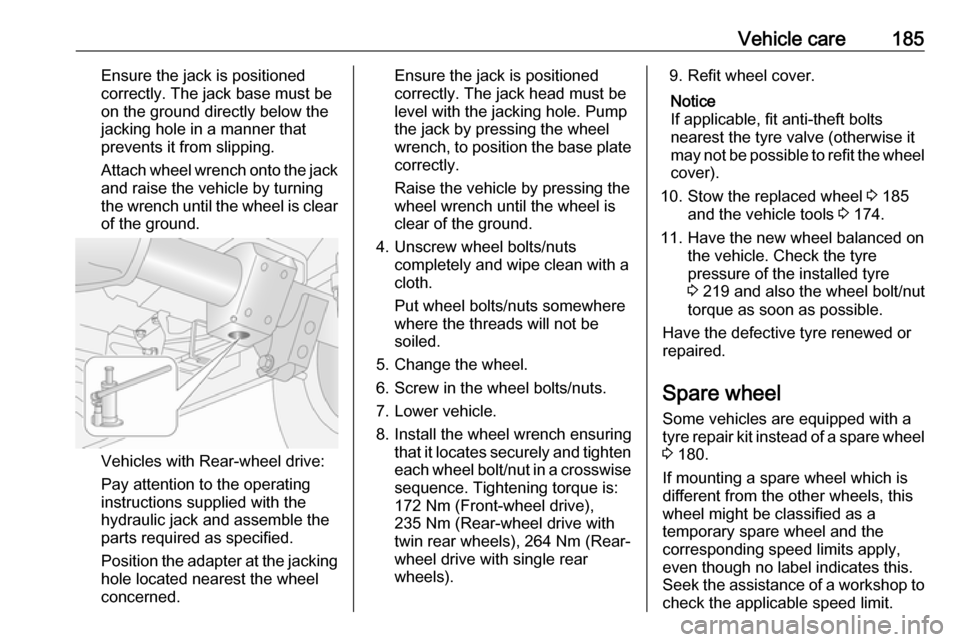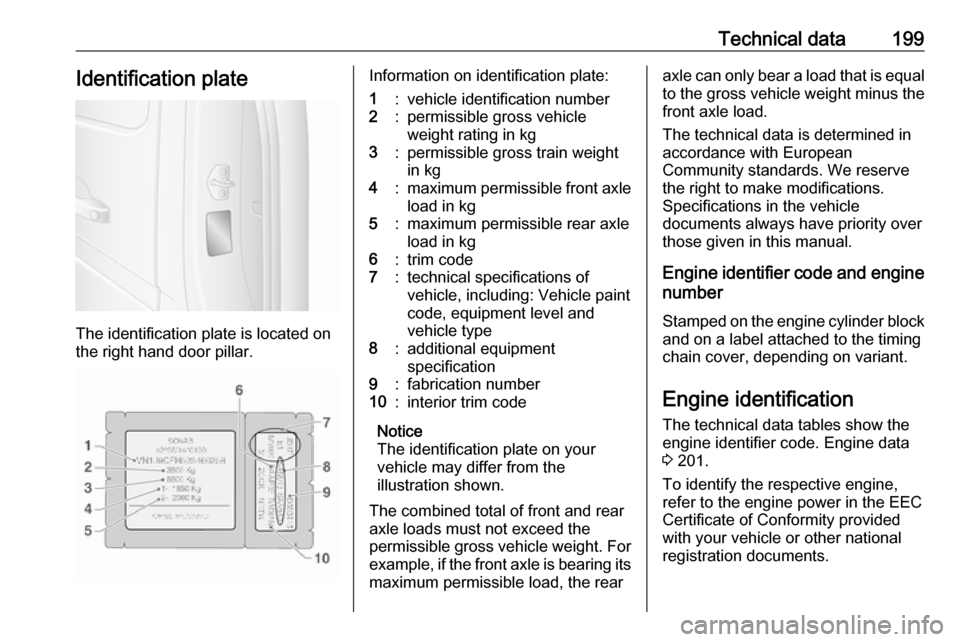Page 187 of 233

Vehicle care185Ensure the jack is positioned
correctly. The jack base must be
on the ground directly below the
jacking hole in a manner that
prevents it from slipping.
Attach wheel wrench onto the jack and raise the vehicle by turning
the wrench until the wheel is clear
of the ground.
Vehicles with Rear-wheel drive:
Pay attention to the operating
instructions supplied with the
hydraulic jack and assemble the
parts required as specified.
Position the adapter at the jacking
hole located nearest the wheel
concerned.
Ensure the jack is positioned
correctly. The jack head must be
level with the jacking hole. Pump
the jack by pressing the wheel
wrench, to position the base plate
correctly.
Raise the vehicle by pressing the wheel wrench until the wheel is
clear of the ground.
4. Unscrew wheel bolts/nuts completely and wipe clean with a
cloth.
Put wheel bolts/nuts somewhere
where the threads will not be
soiled.
5. Change the wheel.
6. Screw in the wheel bolts/nuts.
7. Lower vehicle.
8. Install the wheel wrench ensuring that it locates securely and tighten
each wheel bolt/nut in a crosswise sequence. Tightening torque is:
172 Nm (Front-wheel drive),
235 Nm (Rear-wheel drive with
twin rear wheels), 264 Nm (Rear- wheel drive with single rear
wheels).9. Refit wheel cover.
Notice
If applicable, fit anti-theft bolts
nearest the tyre valve (otherwise it
may not be possible to refit the wheel cover).
10. Stow the replaced wheel 3 185
and the vehicle tools 3 174.
11. Have the new wheel balanced on the vehicle. Check the tyre
pressure of the installed tyre
3 219 and also the wheel bolt/nut
torque as soon as possible.
Have the defective tyre renewed or
repaired.
Spare wheel Some vehicles are equipped with atyre repair kit instead of a spare wheel
3 180.
If mounting a spare wheel which is different from the other wheels, this
wheel might be classified as a
temporary spare wheel and the
corresponding speed limits apply,
even though no label indicates this.
Seek the assistance of a workshop to
check the applicable speed limit.
Page 189 of 233

Vehicle care187
When reinstalling a spare wheel, first
attach the mounting plate (twin rear
wheel vehicles) and secure with the
nut.
Place wheel upright, then route the
cable and connected retainer from
the front of the wheel (side with tyre
valve) and through the centre of the
wheel. Attach the retainer and clip it
into place, ensuring it is correctly
positioned and that the front of the
wheel (side with tyre valve) will be
facing upwards when reinstalled.
Place wheel below the vehicle frame,
directly beneath the winch
mechanism, then tighten cable using
the wheel wrench and adapters by
connecting to the slot position
illustrated above and turning wrench
anticlockwise until the wheel is
secured in the fully raised position.9 Warning
Ensure the front of the wheel (side
with tyre valve) is facing upwards
when the spare wheel is
reinstalled below the vehicle
frame.
Temporary spare wheel
Caution
The use of a spare wheel that is smaller than the other wheels or in combination with winter tyres
could affect driveability. Have the defective tyre replaced as soon as
possible.
Only mount one temporary spare
wheel. Do not drive faster than
50 mph. Take curves slowly. Do not
use for a long period of time.
If your vehicle gets a flat tyre on the
rear while towing another vehicle,
mount the temporary spare wheel in
the front and the full tyre in the rear.
Tyre chains 3 180.
Summer and winter tyres
If you use winter tyres, the spare
wheel may still be fitted with a
summer tyre.
If you use the spare wheel when it is
fitted with a summer tyre the vehicle's driveability may be affected,
especially on slippery road surfaces.
Directional tyres Fit directional tyres such that they rollin the direction of travel. The rolling
direction is indicated by a symbol
(e.g. an arrow) on the sidewall.
Page 196 of 233
194Vehicle careThe instrument cluster and the
displays should only be cleaned using
a soft damp cloth. If necessary use a
weak soap solution.
Clean fabric upholstery with a
vacuum cleaner and brush. Remove
stains with an upholstery cleaner.
Clothing fabrics may not be
colourfast. This could cause visible
discolourations, especially on light-
coloured upholstery. Removable
stains and discolourations should be
cleaned as soon as possible.
Clean seat belts with lukewarm water or interior cleaner.Caution
Close Velcro fasteners as open
Velcro fasteners on clothing could damage seat upholstery.
The same applies to clothing with
sharp-edged objects, like zips or
belts or studded jeans.
Plastic and rubber parts
Plastic and rubber parts can be
cleaned with the same cleaner as
used to clean the body. Use interior cleaner if necessary. Do not use any
other agent. Avoid solvents and petrol in particular. Do not use high-
pressure jet cleaners.
Page 201 of 233

Technical data199Identification plate
The identification plate is located on
the right hand door pillar.
Information on identification plate:1:vehicle identification number2:permissible gross vehicle
weight rating in kg3:permissible gross train weight
in kg4:maximum permissible front axle load in kg5:maximum permissible rear axle
load in kg6:trim code7:technical specifications of
vehicle, including: Vehicle paint
code, equipment level and
vehicle type8:additional equipment
specification9:fabrication number10:interior trim code
Notice
The identification plate on your
vehicle may differ from the
illustration shown.
The combined total of front and rear
axle loads must not exceed the
permissible gross vehicle weight. For
example, if the front axle is bearing its
maximum permissible load, the rear
axle can only bear a load that is equal
to the gross vehicle weight minus the front axle load.
The technical data is determined in
accordance with European
Community standards. We reserve
the right to make modifications.
Specifications in the vehicle
documents always have priority over those given in this manual.
Engine identifier code and enginenumber
Stamped on the engine cylinder block
and on a label attached to the timing
chain cover, depending on variant.
Engine identification
The technical data tables show the
engine identifier code. Engine data
3 201.
To identify the respective engine,
refer to the engine power in the EEC
Certificate of Conformity provided
with your vehicle or other national
registration documents.
Page 222 of 233
220Technical dataRear-wheel drive, with twin rear wheelsTyre pressure with full load11)EngineGross Vehicle WeightTyreFront
[kPa/bar] (psi)Rear
[kPa/bar] (psi)M9T3500195/75 R16 C420/4.2 (61)420/4.2 (61)4500195/75 R16 C420/4.2 (61)420/4.2 (61)11) The spare wheel should be set to the highest applicable pressure shown in the table.
The tyre pressure information label on the driver's door frame indicates the original equipment tyres and the correspondent
tyre pressures. Always inflate tyres to the pressures shown on the label.
Tyre pressure information label 3 176.